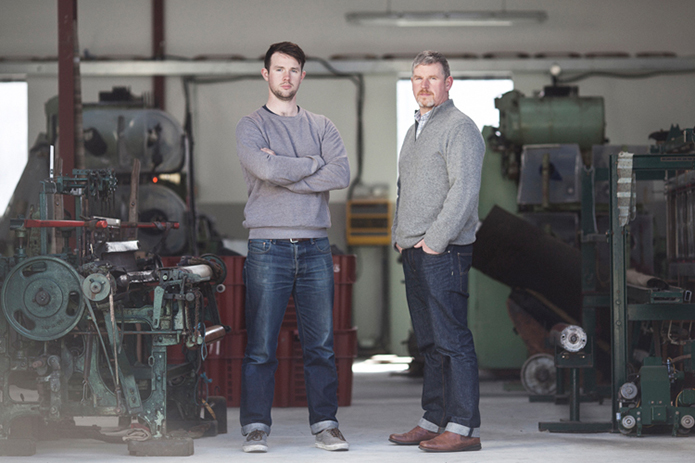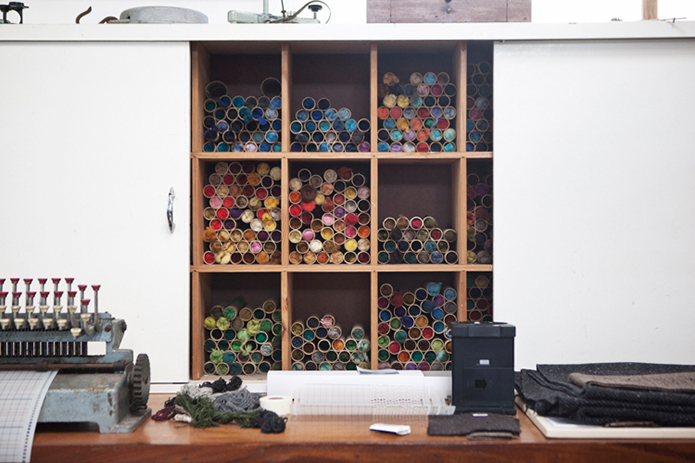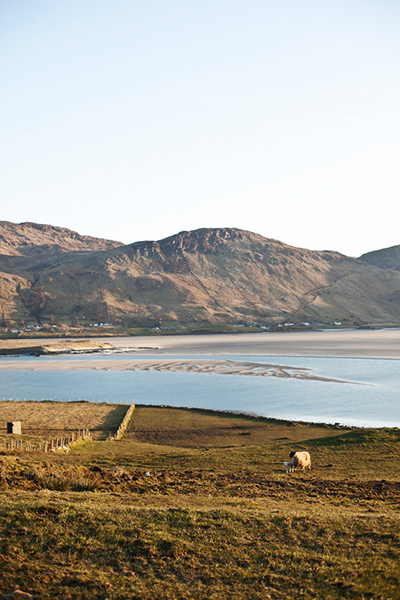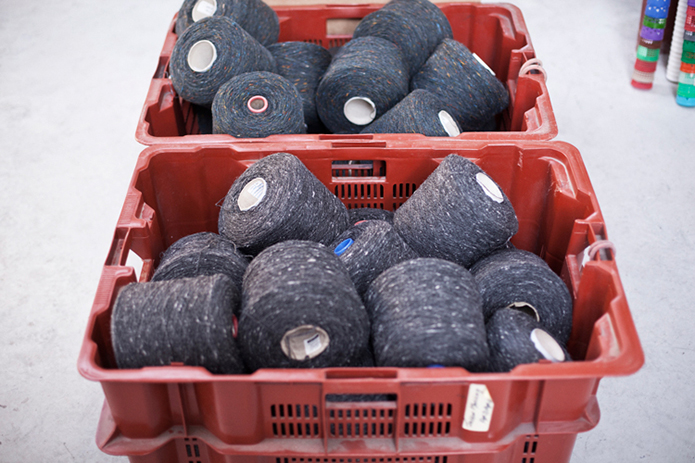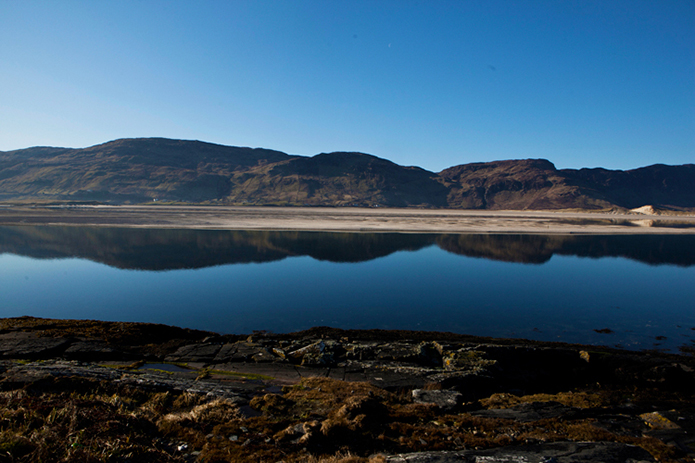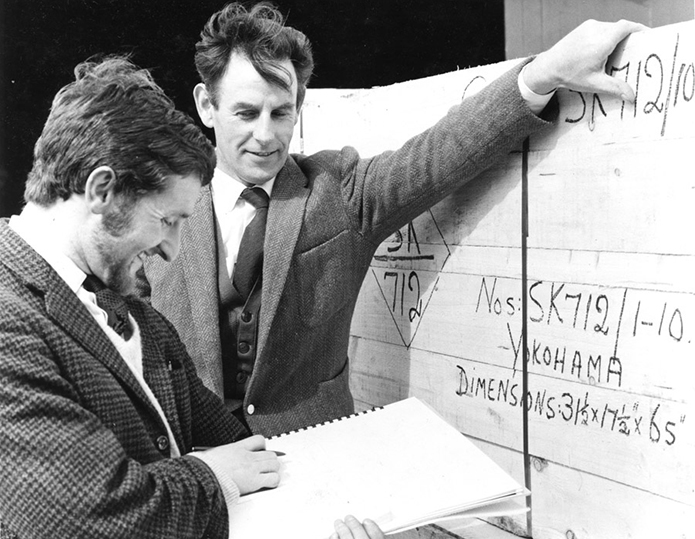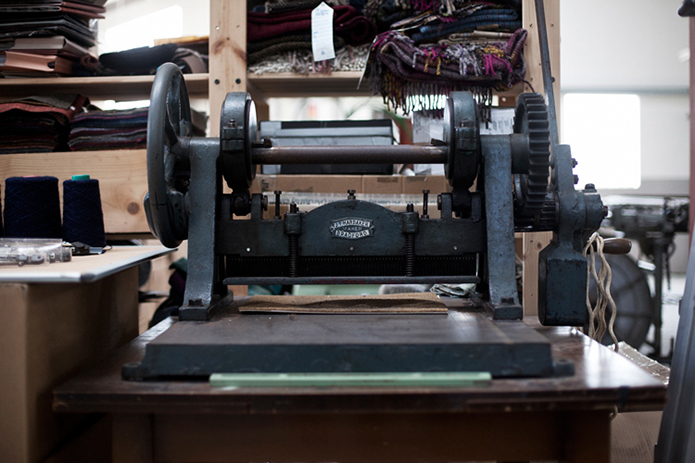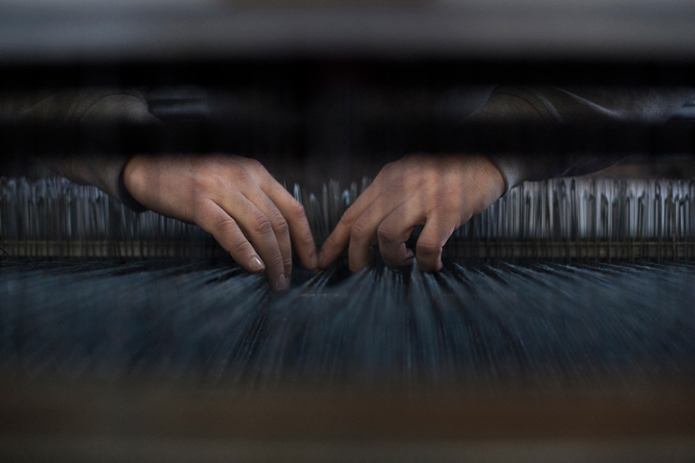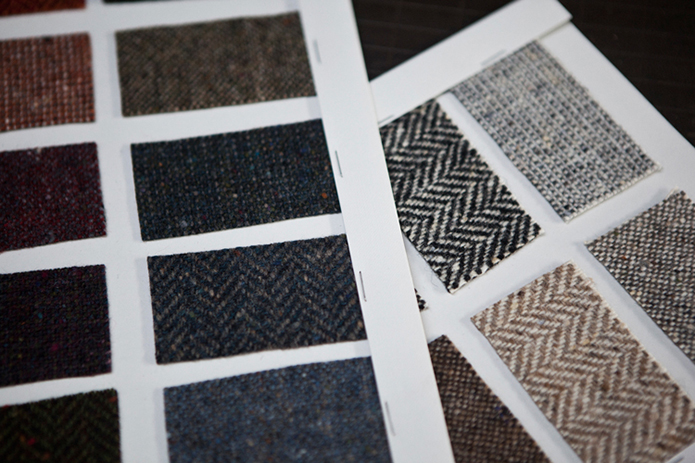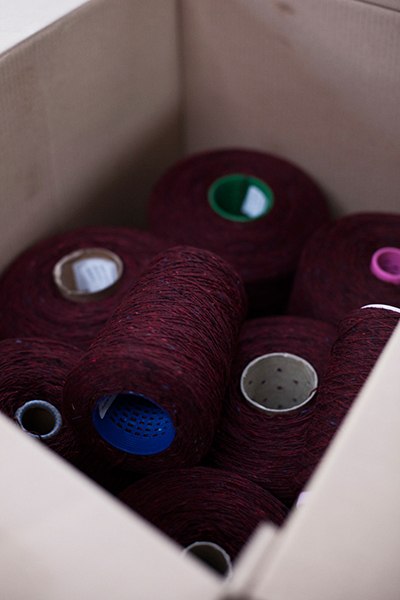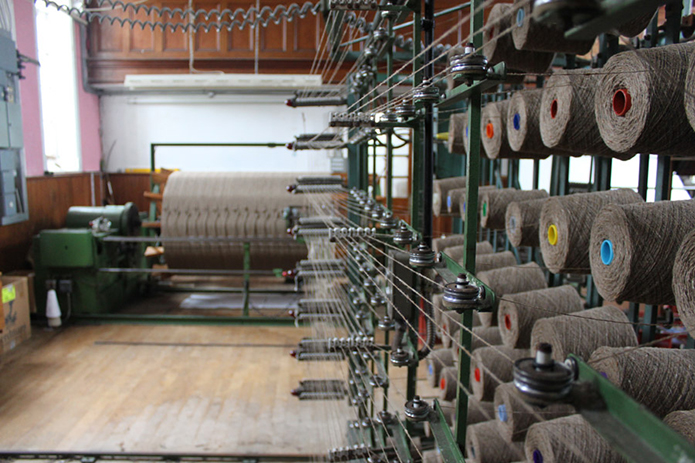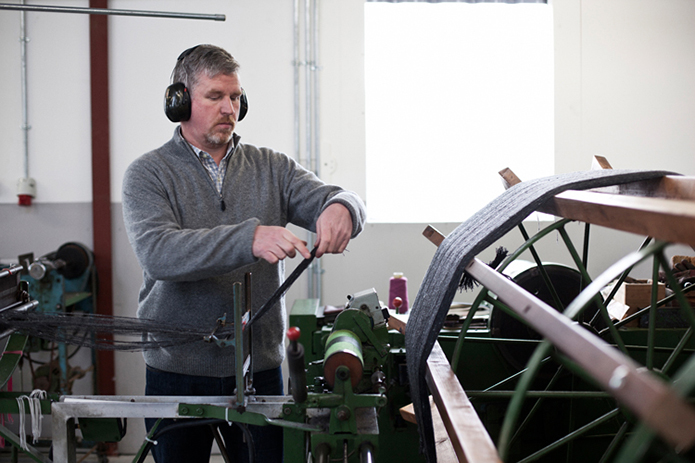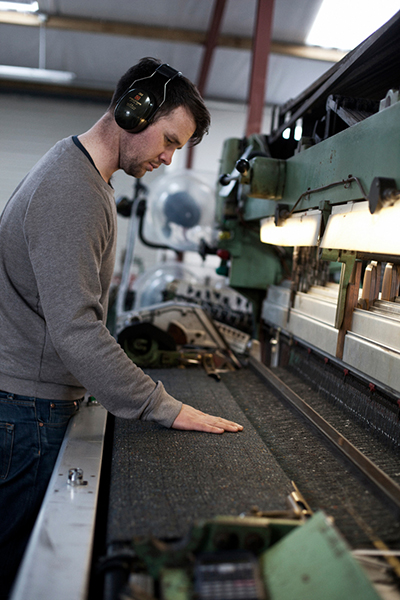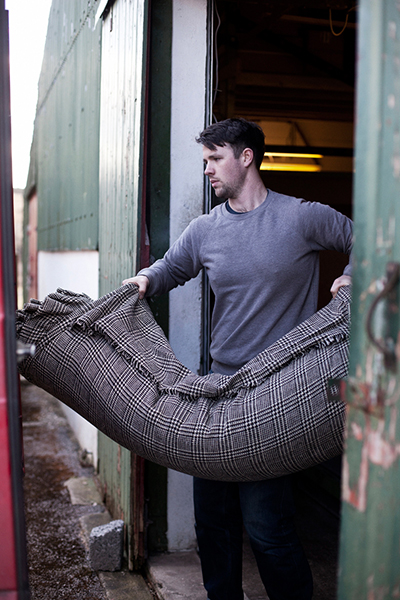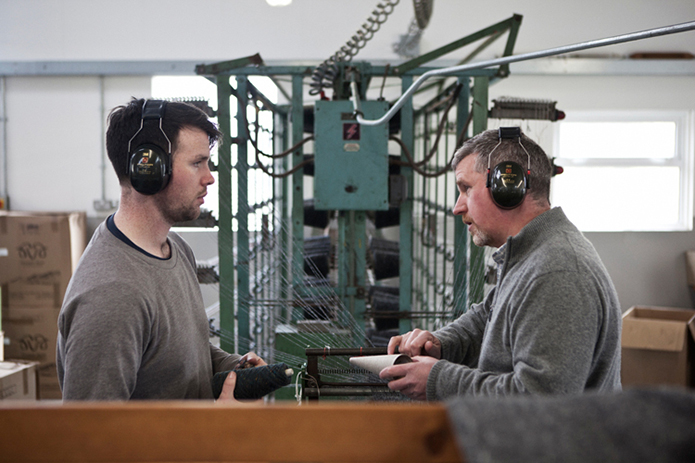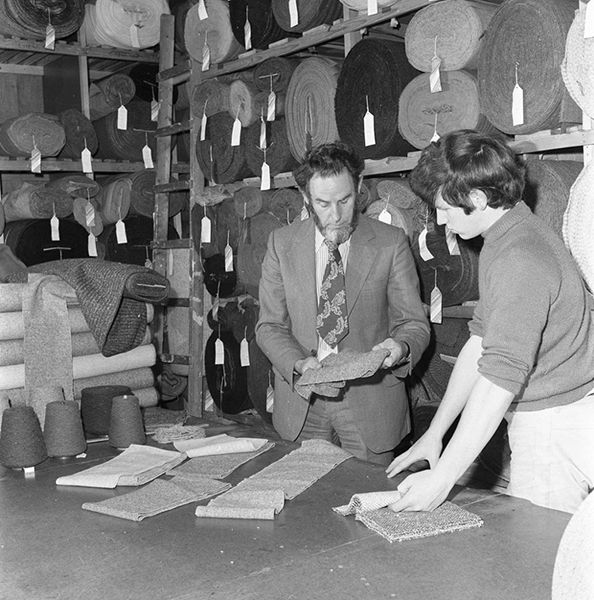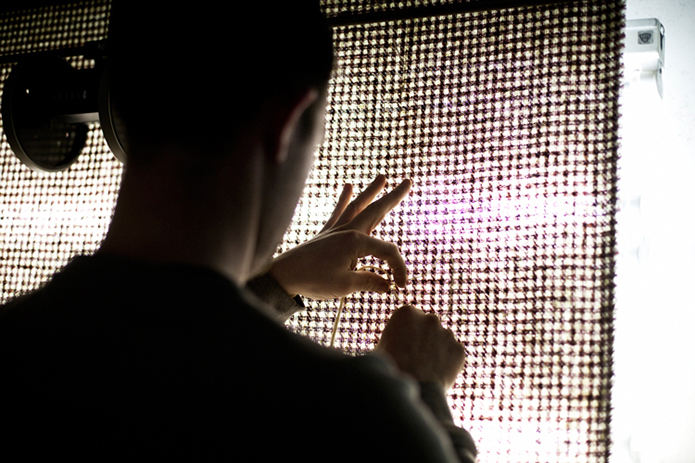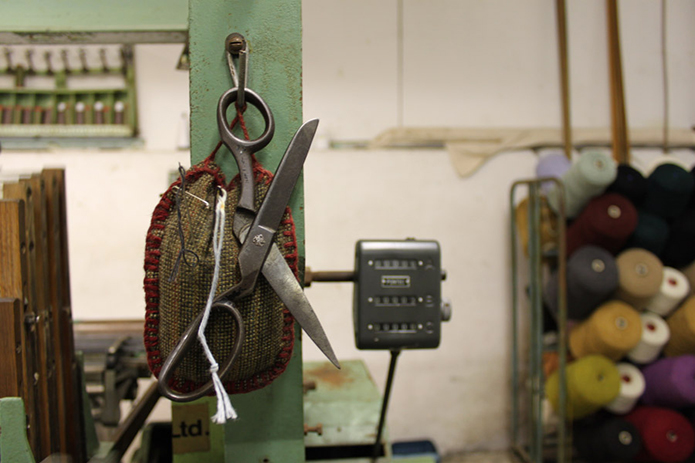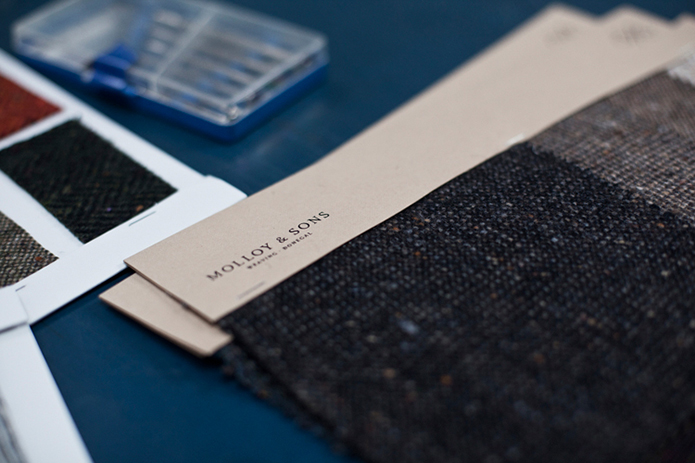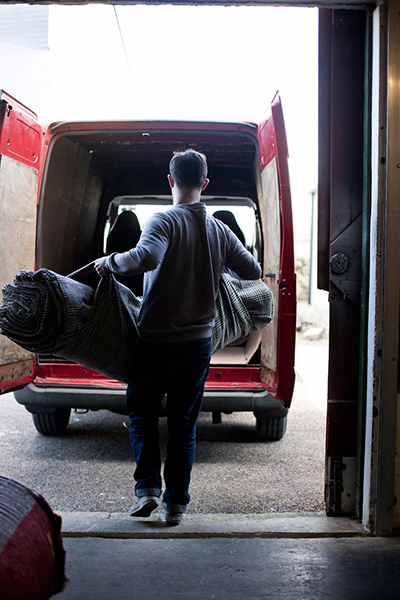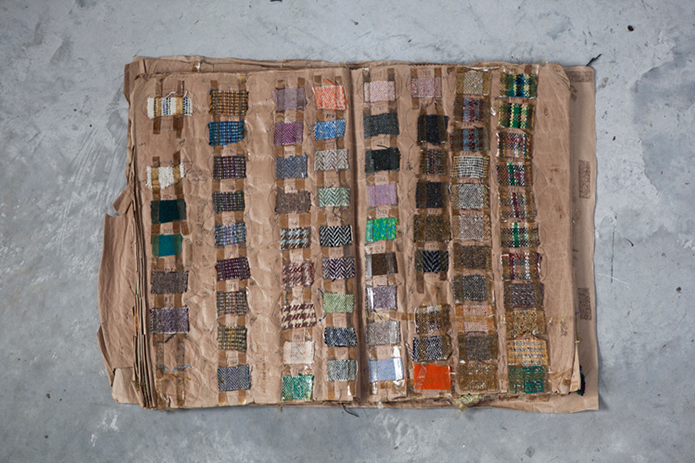
The raw drama of the landscape, the mountains and moorland, the sea and sky, of the north western-most tip of the Republic of Ireland, County Donegal, is mirrored in the natural beauty of its most historic craftwork: Donegal tweed. The rugged north west margins of the British Isles; notably County Donegal as well as the Scottish Outer Hebrides (the isle of Lewis and Harris most notably), have for centuries been utilising the local materials; soft wool from upland sheep breeds (especially Cheviot and Galway) that make this beautiful but harsh environment their home, providing the raw ingredients for an age-old cottage industry; the home-spinning and weaving of woollen yarns for personal use, through to local, national and international trade over the last couple of centuries.
However with this internationalisation of a local product comes the inevitable cheap imitations, and as there are no trade protections for Donegal tweed (unlike its Scottish cousin Harris), ‘Donegal style’ could have been produced in China, and the like, at a fraction of the cost, and even less of the authenticity. This has had a major impact upon the local tweed industry, with many textile workers finding themselves unable to compete with these mass-produced cheap imitations, which the non-discerning consumer has sadly settled for, in the quest for ‘a bargain no matter at what cost – as long as it doesn’t cost me’ epidemic.
Truly authentic yarn produced in Donegal is distinguished, however, by the ‘fleck effect’, where contrasting colours from the indigenous flora; such as berries, gorse, heathers and moss, whose natural dyes bring vibrant colours to the local wools, are cleverly blended to create a planned imperfection, colours dotted as if by chance along the surface of the yarn. This ‘perfect flaw’ demarcating the authentic fabric from inferior imposters, echoing both the colours, idiosyncrasies and the enigmatic subtlety that makes the natural world, in this case, the flora and fauna of north-west Ireland, effortlessly beautiful, is a magical twist Molloy & Sons; a father-and-son owned woollen mill based in Ardara, Donegal, are masters at.
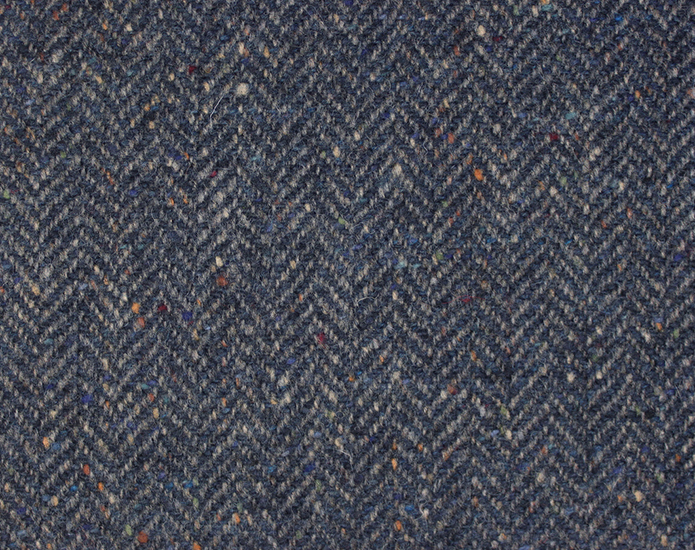
Here, we gain a special insight into one of the last remaining companies who can rightly claim to be making real Donegal tweed, as Kieran Molloy, co-owner of Molloy & Sons, talks us through the realities of a 21st century tweed weaver…
ABOUT MOLLOY & SONS
Kieran Molloy, an industrial design graduate, has, along with his father Shaun, decided to, in their own words “represent the history of the past, the ambition of the future, and the ever-present beauty of the Atlantic coast of Donegal”, by nurturing the legacy and craftsmanship of their ancestors, since the 19th Century, within the contemporary techniques they have adopted and fine-tuned, like their decades-old, traditional tools and machinery to create a real artisanal product and a commitment to the staple, yet struggling local industry of textiles in this bleak but beautiful area.
Firstly, for those readers that aren’t familiar with Molloy & Sons, please can you explain what you do?
We are a small weaving company in Ardara, which is a small coastal village in County Donegal, situated in the rugged north west of Ireland. We weave authentic Donegal tweed in an area which has a strong textile tradition and recognised as the home of the Donegal tweed weaving industry. All our yarn is sourced from local spinners, and the washing and finishing of our cloth is carried out by a company only 20 miles away. Our tweed cloth is made to whatever patterns our customers want and the finished tweed is shipped all over the world. We believe our Donegal tweed is the finest available.
What is the main character of Donegal tweed that makes it so special?
It’s the coloured flecks, or ‘nepps’, in the yarn which is the defining characteristic of Donegal tweed, which are spots of colour added and scattered throughout the yarn by the yarn factory. Donegal tweed is typically woven from three to six base colours, but the flecks are added to bring brightness and interest to the cloth; sometimes contrasting colours, other times complementary, depending on the pattern.
The colours of the cloth reflect the full spectrum of rich colours found in the Donegal landscape; the natural white and black of the sheep, the blues, grey and greens of the Atlantic shoreline, the purples, browns and greens of the heather moorland, and the blues, reds and yellows of the changing colours of the sky and sunrises and sunsets.
The unique style of Donegal tweed has been unchanged for centuries. The style originates from a time many hundreds of years ago when the people of County Donegal wanted to wear bright and varied colours in their clothing but due to the scarcity and cost of natural dyes (this was long before chemical dyes), it wasn’t possible to produce large quantities of multi-coloured cloth. It was easy to create a light or dark coloured wool, as that was from the natural colour of the white or black sheep. But to have varied colours, such as yellow, this would need to come from lichens found on rocks, which was time-consuming to collect, and very scarce. A glossy black colour would come from mud from bogs combined with chips of oak bark. Purples would come from bilberries, which were seasonal. So rather than forego colour altogether, small quantities of coloured wool would be made using natural dyes; they would be felted, washed and dried and then cut into small pieces and added to the yarn as small specks or spots. This would add interest and colour into the base colours to brighten them up.
Can you provide a bit of background as to the long tradition and heritage that County Donegal has with textiles?
My own family connection with textile weaving goes back six generations in County Donegal, but the heritage goes back far beyond that. In fact, the area is also famous for linen-making, but this is more recent than wool. Weaving has been carried out here for hundreds of years, before it became a sophisticated industry; farmers that owned a flock of sheep would card-up some wool and take it to the local weaver, which were found in every settlement, to turn into cloth.
It’s hard to say how far back in time the area became known for its distinctive Donegal tweed, as there aren’t accurate records. What is interesting, though, is when I visited the Medici map room in the world-famous Palazzo Vecchio in Florence, there were a range of maps dating from the early 1500s, and the map of Ireland showed Donegal as an area grossly out of proportion to the rest of the map of Ireland (it was the same size as the rest of Ireland put together), which showed it must have been an important region it its own rights. There was also a major port shown on the map called Teelin, which is now just a tiny harbour-side village with only 250 residents, but back then is must have been a very important port.
The only logical conclusion I have reached as to prominence of Donegal in the wider world several hundred years ago was that it was either an area renowned for its cloth or its fishing industry. On the assumption that the Mediterranean would have had plentiful supplies of fish already, then it makes me think that it was the cloth that was so special. There’s really nothing else could have been taken from here, as it wasn’t famous for any crops, animals or mineral deposits. To my mind, the old chieftains in Donegal were exporting Donegal tweed cloth to the Med, and bringing things like wine back with them.
Whilst weaving was very important to the area before the Famine, it suffered a great deal as a result of it, with so many people dying and emigrating, the industry suffered as a lot of the skills were lost. It was revitalised afterwards, however, with the use of better types of hand looms and spinning techniques and there were thousands of people employed weaving tweed, but also knitting Aran sweaters. Weaving companies were becoming more sophisticated at promoting their products abroad around the turn of the last century, and this was something my family were involved in, often making trips to America, where they had established a large warehouse. It was my family’s business, and Magee’s, which were the two largest exporters of Donegal tweed from Ireland.
Did you have problems sourcing your looms and other machinery when you set up the venture?
Not really. My Dad and I set the company up in 2010, but before that my father worked for his Dad’s company for 30 years, and this was based in weaving sheds right next to where I grew up. So we have used the same equipment as my Grandfather used, and we’re utilising the same premises. The machinery is all fairly modern, with looms from the 1970s. What we didn’t have, but needed, was easy to obtain.
Who are your typical customers?
Most demand for our cloth comes either from fashion companies with their own stores, or garment manufacturers who make their own products. About three quarters of our cloth is used for menswear. Japan and USA are our biggest markets, then the UK; Ireland represents only 5%.
Authentic Donegal tweed is very popular in Japan, as they really have an appreciation for craft and traditional materials. They really seem to want to understand the origin of a product, and delve into and understand its background and story. It’s why they seek out authentic Donegal tweed made in Donegal, and not substitutes. The Japanese are prepared to pay a bit more for authentic Donegal tweed, not just because they know it’s a really good cloth, but because of the story and knowing that it’s made by a sixth generation father-and-son team in a weaving shed on the side of a hill in rugged Donegal, rather than mass-produced thousands of miles away – they’re not basing their buying decisions on price-point alone.
As to why our tweed is popular in America? I think it’s because there has been a long tradition in America of wearing tweed, especially Donegal tweed, and Americans feel really comfortable wearing classic materials.
Do you create or commission your own tweed, or is your style dependent on what your customers ask for?
We create all of our own designs, based on an archive of patterns that go back to the 1960s, but we also bring out new patterns each year, coming up with something slightly different, working in new yarns and colours. Our customers are very welcome to ask for a particular specification, and we can match samples, but obviously there’s no point us making tartans or Shetland cloth, as that’s not what we’re known for: our speciality is plain, simple and dobby weave Donegal tweeds.
Could you briefly guide us through the production process for how you make your tweed?
The process of making our tweed starts with us designing a pattern, or picking one of our historic patterns. We commission and buy yarn from local suppliers using dyed wool to match our specifications, which has the flecks already added to it, as required.
We then work the cloth, working out how much yarn we will require to make, say, 100 metres of cloth at a width of 1.5 metres wide. The yarn is taken from its cones to a warping machine which sets up the length of the cloth ready to be woven; we build the yarn up in 100 millimetre widths at a time.
Depending on the length, there will be, say, 100 metres of yarn wrapped around the drum, and every colour has to be added in the right place ready for weaving.
We then put the weaving pattern into the mechanical pattern loom which is controlled by a punch card and the yarn is woven. The loom works by lifting up-and-down the long threads (called warp), so that the weft (left-to-right) yarn can be shuttled through them, weaving over-and-under, back-and-forth.
We have to keep a close eye for any knots or broken threads, so it can be sorted out there-and-then, rather than later, as it would be disastrous if these were left ignored, and the cloth-wearer would have annoying lumps against their skin. The cloth is loaded onto a huge roller where it’s check for any problems.
The cloth is then sent to the finishing company to get the right ‘handle’ or texture and ‘feel’ – when it comes off the loom it is stiff and harsh, but the finishing both thickens and softens it. Oil, like lanolin, is necessary when the yarn is being woven, as it makes the wool go through the machinery easier, but it needs to be washed out, as well as any other impurities. The wool is put through a mangle and then stretched out using tenterhooks in a tenter machine where it dries; it’s where the phrase ‘on tenterhooks’ comes from, relating to wool stretched out being in a state of tension. The cloth is then put in a machine where steam is added and then vacuumed out, and then it’s given a final press finish. It’s then brought back to us where we inspect it, prior to rolling it up and then putting it in bags, ready to be dispatched.
You went away to Dublin to complete an industrial design degree. What made you come back home to establish Molloy & Sons with your father?
Whilst I went to college to study industrial design, weaving has always been part of my life. I was brought up next door to the weaving sheds owned by my family, and I’ve basically grown up with textiles. Whilst I had many part-time jobs associated with weaving, helping out my family, as a teenager I didn’t really want to do what my parents did, as is common for many people at that age; I wanted to forge my own career doing something different, so I went away and studied industrial design. I worked in industrial design for a few years and realised it wasn’t for me long-term. During that time, as I got older, I gained more of an appreciation of my family history, and could also see the potential of the business selling authentic Donegal tweed internationally and thought it was a great opportunity to join forces with my father. I was never pressured to do this though, and it was completely my decision, and I’m pleased I did.
You are the sixth generation in the Molloy family to be involved in weaving; how important is it to you and your family that this is continued?
It’s important, for sure. It would be an awful shame if we abandoned the story of weaving in Donegal, and also to keep the connection going between my family and weaving. Not many people can say their Donegal tweed weaving family goes back six generations, and that’s important from a family point of view, but also from a business perspective.
What issues are affecting production of Donegal tweed in Ireland?
The main thing is the fact that anybody can legally make a cloth and call it Donegal Tweed, so long as it’s of the right pattern, as it’s not protected. There are companies that making Donegal tweed all over the world, but they don’t have any connection with Donegal at all; in fact 90% of Donegal tweed is not made in Donegal. We are competing with people that are making Donegal tweed ‘style’ but not authentic Donegal tweed, and part of our job is educating people as to why our tweed costs more than the mass-produced foreign-made versions.
I think the other issue is that in the future, as we look to expand our business and take on additional staff, I anticipate it will be quite difficult to find the right people with weaving experience, as there just aren’t the companies out there doing what we’re doing – there’s either a very large weaving company employing 60-70 weaving staff, all with specialist roles, or individual hand-weavers making blankets and that sort of thing, but not people with the all-round experience that we will require. I imagine we will have to do a lot of training in the future.
Can you see a similar situation occurring in Donegal similar to Harris Tweed, whereby a tweed authority is set up, and it is protected by a trademark and certification mark, enshrined in law?
Sadly, I don’t think it’s going to be possible now. There used to be a Donegal Tweed Handweavers Association. My granddad, and many others, would have been involved in that once, but it fizzled out in the 1990s when a lot of companies closed down, but there’s never been a Donegal Tweed authority covering the entire industry. There were attempts once, but the politicians weren’t interested – they were more focussed on European Union matters at the time, and they just saw Donegal tweed production as a dying industry.
As time has passed, with so much Donegal tweed now being been made overseas, it has become a generic name synonymous with the flecky plain-weave pattern of the cloth, rather than the producers of it. How you could realistically get all the producers to stop now – it would be very difficult and tenuous to get a trademark of its character. Things may have been different if the Handweavers Association had kept going, and they had extended their reach over the wider industry, but now there’s so few people working in the industry, I think it would be very difficult. Based on turnover, some of these overseas producers are ten times bigger than us, and we couldn’t afford the costs of taking legal action in any case.
Possibly the best option would be to refer the matter to the EU, and request that it is included as a Protected Designation of Origin, in the same way as Parma ham and Arbroath smokies are, so the EU commissioners look at it instead of lawyers. I think educating people on the authenticity of the product is the best option for us right now.
At the moment, Molloy & Sons is a father-and-son team; what plans do you have for the business in the future?
It would be nice to get a little bit bigger, but we’ll grow things slowly and organically, as we’re in no rush. It would be nice to employ one or two more people, but we don’t have aspirations to have 100 people or so. My grandfather used to employ 30 weavers in the weaving sheds, and up to 2,000 people knitting items for him, like Aran sweaters. We definitely don’t have grand plans to be a massive company like that, and we’d just like to grow at a pace we can handle.
We will continue to sell to markets where our products have already been well-received, as it makes sense to try and increase our market share there, rather than focussing on completely new markets. We’re gradually selling more cloth into the likes of German, French and Scandinavian markets, and it would be nice to do more. We’re slowly getting there!
Thanks to Kieran Molloy for taking time out of his busy schedule to answer our questions.

